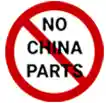The fuselage is one of the foundational components of an aircraft, serving as the main structure that houses crew, passengers, cargo, and other vital systems. Whether on a small private plane or a large commercial jet, the design of a fuselage directly impacts the performance of an aircraft. In this blog, we will explore different types of fuselages found on planes, explaining their characteristics and uses in aviation.
The term "monocoque" is derived from French and means "single shell." This type of fuselage features a smooth and continuous outer skin that encloses an aircraft and distributes forces evenly across the surface, much like the shell of an egg. As a result, monocoque variants are commonly found in smaller aircraft, where the simplicity of this design contributes to weight reduction and ease of construction.
The semi-monocoque fuselage skillfully integrates important aspects of both monocoque and framed structures, offering a balanced solution. In this design, a carefully constructed internal framework made up of ribs, stringers, and bulkheads works in tandem with the outer skin, allowing both to share the responsibility of carrying the structural load. This combination results in a fuselage that is considerably stronger than the simpler monocoque type while still having solid aerodynamic performance.
A truss fuselage utilizes a framework composed of welded or bolted metal tubes to provide the essential structural support for an aircraft. While this type is no longer regularly seen in modern commercial aviation due to its lack of aerodynamic efficiency, it still finds use in specific types of lightweight planes and small trainers where simplicity is often valued. Additionally, the straightforward design of the truss fuselage makes it relatively easy to construct and repair.
A wide-body fuselage refers to the larger, broader design commonly found in commercial aircraft meant for long-haul flights like the Boeing 747 or Airbus A380. These planes have two aisles, which allow them to accommodate a greater number of passengers—usually between 200 and 600. Furthermore, wide-body options provide ample space for cargo storage beneath the deck, making them optimal for freight transportation.
A narrow-body fuselage is specifically designed for shorter flights and is characterized by having only one passenger aisle. Aircraft in this category, such as the Boeing 737 or Airbus A320, typically accommodate a smaller number of passengers, usually between 100 and 240 depending on the chosen seating configuration. Moreover, the simpler design of narrow-body variants often results in reduced maintenance requirements, which adds to their appeal and widespread use among airlines for regional routes.
If you find yourself in need of fuselage products, landing lights, or other aircraft components, Aviation Spare Source is your sourcing solution with a myriad of parts available for purchase today. We invite you to explore our extensive offerings at your own pace, and be sure to request quotes on any items of interest you come across with our online RFQ forms. Once we receive and review your submission, a competitive response will be supplied in 15 minutes or less. With our representatives accessible around the clock to assist, we would be delighted to serve as your strategic fulfillment partner for all your operational requirements.
Posted on February 7, 2025 david jason



“We Proudly Support Intrepid Fallen Heroes Fund that serves United States Military Personal experiencing the Invisible Wounds of War : Traumatic Brain Injury (TBI) and Post Traumatic Stress (PTS). Please visit website (www.fallenheroesfund.org) and help in their valiant effort”.
We Hope that You Will Visit Us Again the Next Time You Need Aircraft Parts and Make Us Your Strategic Purchasing Partner.
Request for Quote